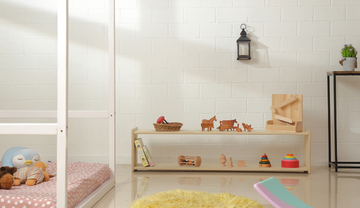Aishwarya Dwarakanath (Montessori guide and consultant)
If you’ve been looking at toys and Montessori-inspired shelves online, then I am sure you would have come across the term- Rotation. Rotation refers to the process of choosing what toys or activities are to be kept on your child’s accessible shelf for a certain period of time. The rest of their toys, if any, are stored in an inaccessible space.

How do we rotate toys?
Start off by choosing a shelf (with 2-3 tiers) and placing 6-9 activities and toys.
-
Place the rest of the toys, if any, in a cupboard or in storage boxes, which can not be accessed by the child.
-
Spread them out in a way that the child can easily reach out and pick the toy off the shelf without bumping into anything else.
-
If you have more than one child, consider using the top tiers for the older child, while the lower shelves may suit your little one.
-
At home, it makes sense to rotate toys based on your child’s interests and developmental stage. Try out toys and activities that might suit their fine motor/gross motor or language developmental needs at this point in time. This is a natural way of rotating toys- completely based on your child’s interests and abilities.

-
If a toy is not being used for 1-2 weeks, you can take a look at the ones in storage. Check for signs of over-stimulation- is your child getting overwhelmed by trying to choose from multiple options? Is there a difference when you keep just 3-4 items on the shelf?
-
When an activity becomes too easy for the child, boredom might creep in. Open-ended toys and slight variations in activities can help the child return to the toys in a new manner.
-
Sometimes, it can be interesting for families to introduce aspects of their culture through stories and artwork that relates to a festival or a theme. Dedicating a section of the shelf to the same can help the child slowly get used to new changes in the home.
Is Rotation important to practising Montessori in schools?
The answer is actually no! However, those practising her philosophy at home have found that rotating toys DO go in line with Dr Montessori’s observations.
Let me explain.
Maria Montessori observed that infants and toddlers (below the age of 4 years) have a high sense of order. They find a sense of security in predictability. Toddlers are constantly exploring their surroundings and need to find reference points to orient themselves. For example, this means that if they are used to seeing slippers outside, they will find it greatly disorienting if one day the slippers find their way inside the home!

This sense of order can be supported by NOT rotating the toys on the shelf too frequently for the child. This is the reason that Montessori Houses of Children and Infant Community centres have the same materials laid out for the children on the same shelves. As the children in the Primary classroom (House of Children) are slightly older (between 3-6 years), they would be able to adjust to slight changes in the environment- like rotating the Language, Art and Culture activities according to a theme, the season or the needs of the children themselves!
At home, we can try to ensure that the child’s sense of order does not get affected by being careful with our rotation. When we want to make a change to the shelf, it helps to gently introduce the change to your toddlers by pointing out the new item on the shelf and showing them how to use the new toy.
As the child becomes 3 years or older, we can expect them to ask for older toys. Don’t feel worried about reintroducing old favourites. A child may find new ways to make new discoveries!






